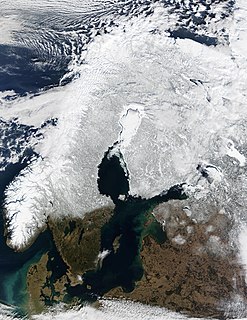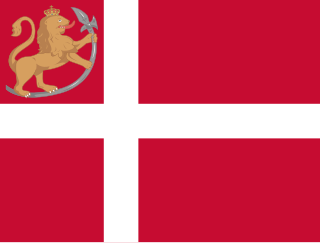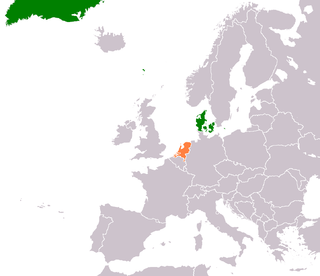
Denmark and the former political union of Denmark–Norway had a colonial empire from the 17th through the 20th centuries, large portions of which were found in the Americas. Denmark and Norway in one form or another also maintained land claims in Greenland since the 13th century.

The history of Denmark as a unified kingdom began in the 8th century, but historic documents describe the geographic area and the people living there— the Danes —as early as 500 AD. These early documents include the writings of Jordanes and Procopius. With the Christianization of the Danes c. 960 AD, it is clear that there existed a kingship. Queen Margrethe II can trace her lineage back to the Viking kings Gorm the Old and Harald Bluetooth from this time, thus making the Monarchy of Denmark the oldest in Europe. The area now known as Denmark has a rich prehistory, having been populated by several prehistoric cultures and people for about 12,000 years, since the end of the last ice age.

Christian IV was king of Denmark and Norway and duke of Holstein and Schleswig from 1588 to 1648. His 59-year reign is the longest of Danish monarchs, and of Scandinavian monarchies.

Christian VIII was the King of Denmark from 1839 to 1848 and, as Christian Frederick, King of Norway in 1814.

Frederick III was king of Denmark and Norway from 1648 until his death in 1670. He also governed under the name Frederick II as diocesan administrator of the Prince-Bishopric of Verden, and the Prince-Archbishopric of Bremen (1635–45).

Frederick VI was King of Denmark from 13 March 1808 to 3 December 1839 and King of Norway from 13 March 1808 to 7 February 1814, making him the last king of Denmark–Norway. From 1784 until his accession, he served as regent during his father's mental illness and was referred to as the "Crown Prince Regent" (kronprinsregent). For his motto he chose God and the just cause and since the time of his reign, succeeding Danish monarchs have also chosen mottos in the Danish language rather than the formerly customary Latin.

Sweden and Norway or Sweden–Norway, officially the United Kingdoms of Sweden and Norway, or as the United Kingdoms, was a personal union of the separate kingdoms of Sweden and Norway under a common monarch and common foreign policy that lasted from 1814 until its peaceful dissolution in 1905.

The Treaty of Kiel or Peace of Kiel was concluded between the United Kingdom of Great Britain and Ireland and the Kingdom of Sweden on one side and the Kingdoms of Denmark and Norway on the other side on 14 January 1814 in Kiel. It ended the hostilities between the parties in the ongoing Napoleonic Wars, where the United Kingdom and Sweden were part of the anti-French camp while Denmark–Norway was allied to Napoleon Bonaparte.

Danish overseas colonies and pre Dano-Norwegian colonies are the colonies that Denmark-Norway possessed from 1536 until 1953. At its apex the colonies spanned four continents. The period of colonial expansion marked a rise in the status and power of Danes and Norwegians in the union. Being the hegemon of Denmark-Norway or the Statsfædrelandet, Denmark is where the union's monumental palaces are now located and Copenhagen, today the capital of Denmark, was the city which both Norway and Denmark came to establish as their capital. Much of the Norwegian population moved to find work in Copenhagen, attend university, or join the Royal Fleet.

In August 1814, after a loss in the Swedish–Norwegian War, Kingdom of Norway was forced to join in a personal union with the Kingdom of Sweden, thereby becoming subject to a naval blockade by the British Empire, but remaining largely autonomous within the union. Although nationalist aspirations were not to be fully realized until the events of 1905, 1814 was the crisis and turning point in events that would lead to a fully independent Norway.

Denmark–Russia relations is the relationship between the two countries, Denmark and Russia. Diplomatic relations between Denmark and the USSR were established on June 18, 1924. Russia has an embassy in Copenhagen and a consulate in Tórshavn, and Denmark has an embassy in Moscow, a Consulate-General in Saint Petersburg, and an honorary consulate in Kaliningrad. Both countries border the Baltic Sea and are members of the Council of Europe and the Organization for Security and Co-operation in Europe.

British–Danish relations are foreign relations between the United Kingdom and Denmark. The United Kingdom has an embassy in Copenhagen and Denmark has an embassy in London. Both countries are full members of NATO and of the European Union, although the United Kingdom plans to leave the European Union.

Denmark–Iceland relations are the foreign relations between Denmark and Iceland. Iceland was a Norwegian dependency since the Middle Ages and thus became part of the Kalmar Union and Denmark–Norway, both entities dominated by Denmark. After the dissolution of Denmark–Norway Iceland was a part of the Kingdom of Denmark from 1814 to 1918 and a separate kingdom in a personal union with Denmark until 1944, when Iceland declared independence. Denmark has an embassy in Reykjavík. Iceland has an embassy in Copenhagen and consulates-general in Nuuk and Tórshavn.

Denmark–Norway, also known as the Dano–Norwegian Realm, the Oldenburg Monarchy, or the Oldenburg realms, was an early modern multi-national and multi-lingual real union consisting of the Kingdom of Denmark, the Kingdom of Norway, the Duchy of Schleswig, and the Duchy of Holstein. The state also claimed sovereignty over two historical peoples: Wends and Gutes. Denmark–Norway had several colonies, namely the Danish Gold Coast, the Nicobar Islands, Serampore, Tharangambadi, and the Danish West Indies.

The English Wars were a series of conflicts between England and Sweden with Denmark-Norway as part of the Napoleonic Wars. It is named after England, the common name in Scandinavia of the United Kingdom, which declared war on Denmark-Norway due to disagreements over the neutrality of Danish trade and to prevent the Danish fleet falling into the hands of the First French Empire. It began with the first battle of Copenhagen in 1801 and its latter stage from 1807 onwards was followed by the Gunboat War, the Dano-Swedish War of 1808–09 and the Swedish invasion of Holstein in 1814.
The military history of Norway commences before the Viking age with the internal wars fought between regional kings to obtain the supreme kingship of the whole of Norway. The most famous period of Norwegian history and thus military history is the Viking age, but the early Middle Ages was the era when Norwegian military power in Europe reached its peak. Since then the Norwegian military has experienced long periods of neglect, but also rearmament and victories.
Treaty of Copenhagen may refer to:

Denmark–Netherlands relations are foreign relations between Denmark and the Netherlands. Denmark has an embassy in The Hague and the Netherlands has an embassy in Copenhagen. Both countries are full members of NATO and the European Union. Princess Beatrix is a Dame of the Order of the Elephant since 29 October 1975. On 31 January 1998, King Willem-Alexander of the Netherlands also received the Order of the Elephant.

Denmark–Switzerland relations refers to the current and historical relations between Denmark and Switzerland. Denmark has an embassy in Bern. Switzerland has an embassy in Copenhagen, but only offers consular services from the Nordic Regional Consular Centre in Stockholm. Diplomatic relations between Denmark and Switzerland were established in 1945.



















